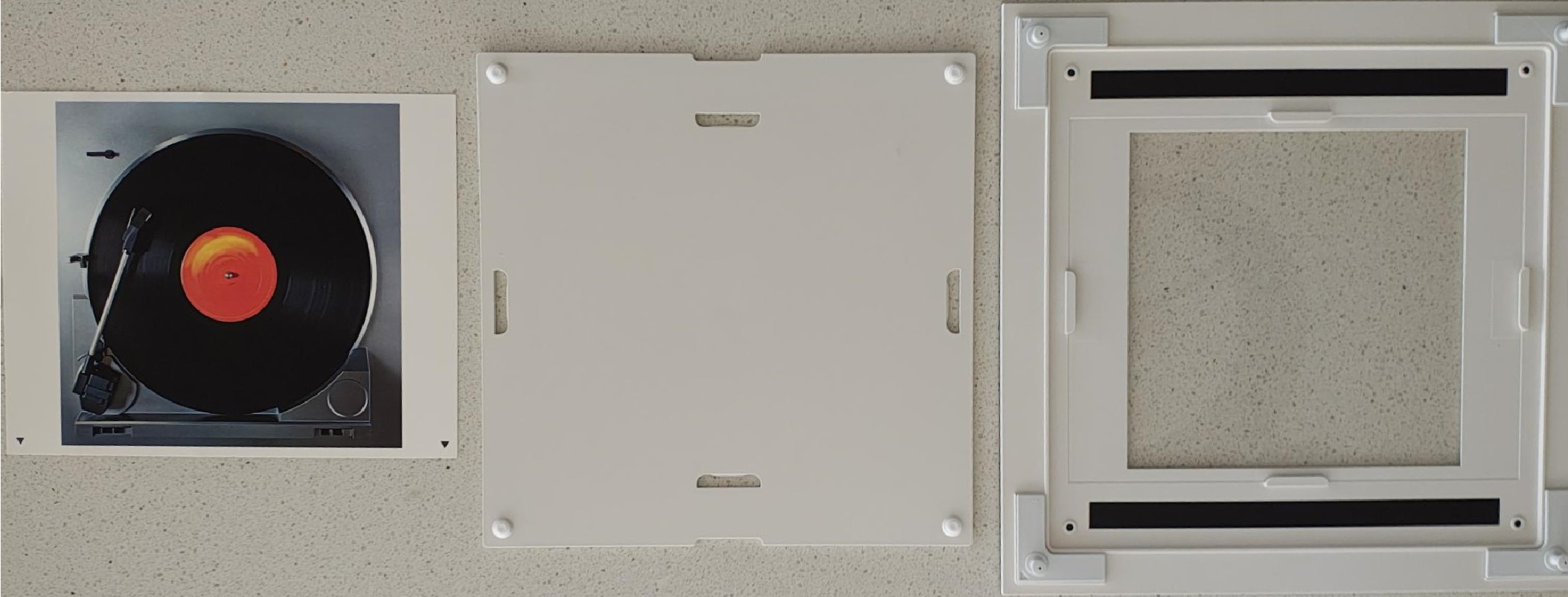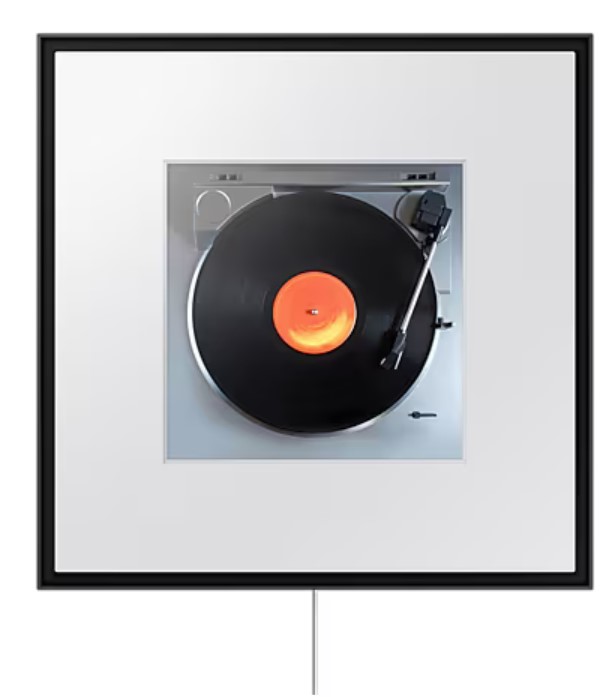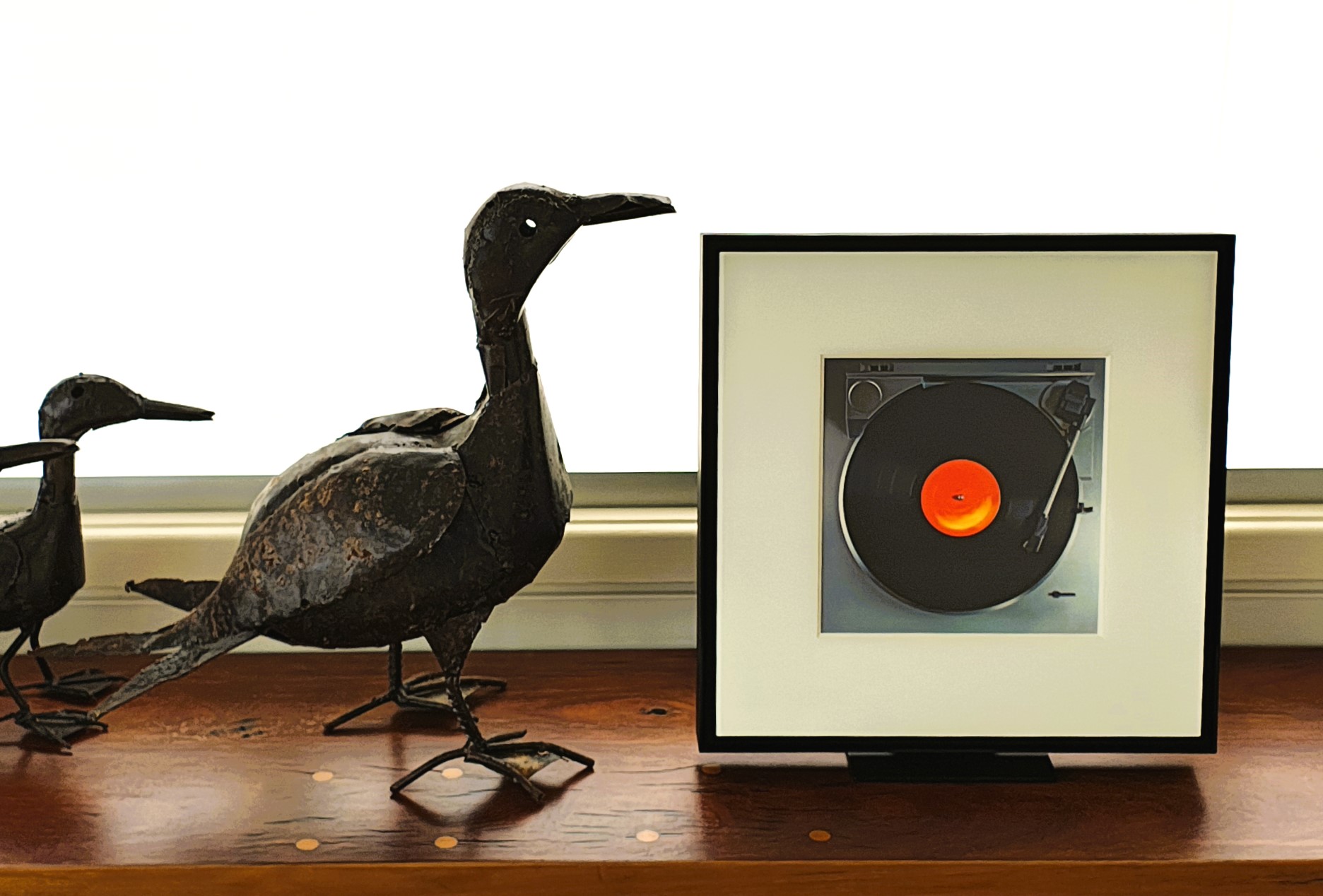The Samsung Music Frame LS60D is a Bluetooth/Wi-Fi/Optical-in, 2.0 speaker inside a picture frame. You add pictures because, without them, it is just a black plastic square that sounds pretty good.
I asked Samsung to send me two Samsung Music Frames to test because I was under the impression that you could use Wi-Fi to stereo-pair or set them up as multi-room speakers. If so, this would mean some serious competition to Sonos, where all its speaker products can do this, and some can act as dedicated rears to its soundbars.
Sorry, this is not the case, so don’t let so-called authoritative reviews tell you otherwise. You are essentially buying a 2.0 standalone speaker with some added features for selected 2024 Samsung TVs and soundbars.
Australian review: Samsung Music Frame LS60D
| Website | Product page User Guide Simple User Guide |
| RRP 5/11/24 | $699 |
| From | Samsung Online and approved resellers |
| Warranty | 12-months ACL |
| Made in | Vietnam |
| Company | Samsung is a South Korean multinational manufacturing conglomerate headquartered in Samsung Town, Seoul, South Korea. Samsung Electronics (the world’s largest information technology company, consumer electronics maker and chipmaker. |
| More | CyberShack Samsung News and Reviews CyberShack TV/AV News and Reviews |
We use Fail (below expectations), Passable (meets low expectations), Pass (meets expectations), Pass+ (near Exceed but not class-leading) and Exceed (surpasses expectations or is the class leader) against many of the items below. You can click on most images for an enlargement.
We are also tightening up on grading. From now on, Pass, for example, means meeting expectations for the price bracket. We consider a Pass mark to be 70+/100 with extra points added for class-leading and excellence.


First Impression – an almost unique concept – art trumps speakers
Ikea was first with the $249 SYMFONISK, a Sonos collaboration. These are stereo-pairable and can act as dedicated rears for Sonos soundbars via Wi-Fi and the Sonos App (and all its streaming services).
Naturally, my first impression was that Samsung would at least match the SYMONISK mono Picture Frame for functionality. It can use your photos/art, and BT/Optical-in beats Wi-Fi only IKEA. But in other ways, it can’t stereo-pair or act as a dedicated rear channel to a soundbar.
I am perplexed that Samsung has released an expensive, high-quality Bluetooth 2.0 speaker with Wi-Fi and Optical-in with limited functionality.
How does the Samsung Music Frame LS60D connect?
Reference – Samsung
- Bluetooth 5.2 connects using SBC, stereo, 16-bit, 44,100Hz codec, i.e., a 2.0 BT speaker.
- Optical-in connects to any sound source with that feature.
- Samsung SmartThings connect via Wi-Fi, i.e., it is a 2.0 Wi-Fi speaker
- You can add more Music Frames via SmartThings and create a group (same music played on each), but you cannot stereo-pair.
- With compatible internet-connected 2024 Samsung TVs, you can use one for TV sound.
- With compatible Q-Symphony soundbars, you can use one to enhance the sound. This does not add any channels, e.g., a 5.1 soundbar does not become a 7.1. After reading Samsung’s user help, it appears that despite a website illustration showing a pair, only one works if both the soundbar and Music Frame use W-Fi (not HDMI). We could not test this.
SmartThings – Pass
SmartThings is Samsung’s all-in-one home automation ecosystem, similar in function to Google Home or Apple HomeKit. It allows you to add Samsung and other brands of Wi-Fi-enabled (and matter-compliant) appliances, air care, clothing care, and more.
We use the term ecosystem because you must have a Samsung account and agree to it, as well as SmartThings privacy policies (at the end of this review). There may be other policies for different Samsung and connected device brands. With respect to Samsung, using a BT/Wi-Fi speaker should not require thousands of words in nested policies!
Its music features are basic:
- Volume: The app provides more granular control than the device’s physical volume control
- Sound source: It does not support BT multi-point so this shows one BT host and Optical-in.
- Sound Mode: Music (natural sound), Standard (unprocessed), and Adaptive Sound (analyses the content for optimal sound quality).
- EQ: +/- 6dB Bass and treble sliders (no presets)
- SpaceFit Sound: Analyses the current listening space to optimise sound.
- Active Voice Amplifier: Recesses frequencies apart from spoken dialogue
- Advanced Sound Settings: Voice enhancement in movies and TV shows, and Night mode to adjust the overall volume while keeping the spoken dialogue clear.
Its Service features include
- Q-Symphony (with Samsung capable devices)
- Alexa built-in (Google Assistant and HomeKit are via the SmartThings integration)
- Spotify
- Chromecast
- Tidal
- AirPlay (Apple Music)
Sound processing
It accepts mono or stereo PCM 2.0, ATMOS Music, Dolby ATMOS, Dolby 5.1ch, and Dolby Digital Plus, downscaled to 2.0.
Microphones – Pass
It has an effective far-field mic of about 5 meters for Alexa Voice commands.
Samsung Music Frames LS60D Tech Specs
- Size: 353.0 x 364.8 x 143.4 mm x 4.6kg
- Power: 9V/2A/18W maximum and .5W standby
- Wi-Fi: N 5Ghz (via SmartThings only)
- BT: 5.2, single point, SBC, 16-bit/44100Hz accepts MP3, AAC, OGG, FLAC, WAV, ALAC, AIFF
- Wall bracket: Yes
- Tap Sound: Late-model Samsung phones only
- Voice: Alexa built-in (others via SmartThings integration)
- Optional Smart Things Dongle VG-STDB10A $39
- Q-Symphony: 2024 compatible TVs and soundbars
- Six speakers (wattage not disclosed but appears to be 6 x 20W amps)
- You can wall mount it, but a silver cable dangles from it, and the rear-firing woofers are impaired.
Picture Frame
It has a substantial 330 x 330mm non-reflecting glass picture ‘cover’ attached to the speaker via corner posts. The image cutout accommodates a 195 x 195 photo in a 255 x 205 matt.

In theory, you can place any photo that fits that size. There are some spare mounting corners/posts for your art. Be careful that whatever you use is acoustically opaque and does not vibrate.
There is a service to turn your art into a mount for US$46 plus freight and customs.

Speakers
It has six speakers. We assume Left/Right tweeters, Left/Right mid-range and Left/Right rear-firing woofers.
The tweeters and midrange drivers are inside, and the sound is emitted through a waveguide along the edge of the frame.
Sound stage and left/right separation
Regardless of sound input, this is a 2.0 speaker.
The stage is relatively narrow because the sound primarily comes from the side waveguides. You hear the 2.0 Left/Right channels quite clearly.
Dolby Atmos content (Music) has a very front-centric 3D height (about 1m over the speaker) and some 2D side surround. It enhances the music rather than adds spatial sound or directionality.
We could not test Dolby Atmos movies as this only works with Samsung 2024 TVs. We tried using the Optical-in and another brand’s TV sound passthrough set to Atmos, but it made no difference. It is not a substitute for a soundbar.
How does it sound?
We test for the native sound signature using white noise and a frequency meter. This is the baseline with which EQs and presets can work by recessing bass, mid or treble frequency.
All tests were in standard, unprocessed mode and replicated on BT, Wi-Fi, and Optical-in. There is no real difference between the native sound signatures, but there is a slight improvement in music quality using Wi-Fi and Optical-in.
It has no low bass (not expected), and mid-bass starts at 50Hz, builds to 85Hz, and is flat through high bass. The bass is quite satisfying.
It is then flat to 2kHz low-mid-mid (good) but starts to lose control with some evident clipping from 2-5kHz. It’s not bad, but I felt the vocals suffered a little, and the sound character was not as well defined.
From 5kHz, it slowly descends to 7kHz to avoid harshness. It then builds to 10kHz and descends fairly choppily to 20kHz. High treble usually adds a sense of direction and ‘air’— it is a little lacking.
Maximum volume is 82dB with distortion, so back off a little to bring that under control.

This warm and sweet signature (bass/mid boosted, treble recessed) is best for easy-listening music and movies. It is not for concert hall music or heavy rock.
The sound modes made little difference, and most will select Adaptive.
CyberShack’s view: If I had my druthers, the Samsung Music Frame LS60D would be different
The good part is that it is a BT, Wi-Fi, and optical-in 2.0 wall or desk-mount ‘art’ speaker, making it excellent for easy music listening. If that is all you want, and budget is not an issue – go for it.
The bad part is the lack of stereo pairing and the use of dedicated rear channels for Samsung soundbars. If they could solve these two issues, these would sell like hotcakes.
The format also limits its sound quality. You can get better sound from desktop speakers like the $399 Sonos Era 100 (2.1) with room tuning, Bluetooth, Wi-Fi, Line-in, AirPlay 2, stereo pairing, and work as rear speakers for the Arc and Beam soundbars.
Our take is an acceptable sound and almost unique as a wall-mountable piece of art.
Samsung Music Frame LS60D Rating
- Features: 85 – Six speakers 2.0, picture frame, BT/Wi-Fi/Optical-in
- Value: 75 – Sonos kills it for sound quality with the Era 100 2.1 at $399
- Performance: 75 – Narrow sound stage, distortion at high volume and a loss of some bass if wall mounted.
- Ease of Use: 80 – BT and Optical-in are simple and don’t require the SmartThings app. Wi-Fi required the app and all those privacy implications.
- Design: 90 – good design – now if we could eliminate the power cable for wall mounts.


CyberShack Verdict
Samsung Music Frame LS60D
$699











Comments